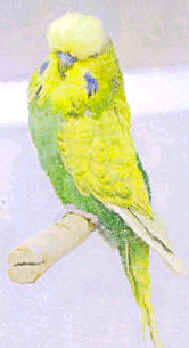Introducing
Spangles to our Stud
by Bob and Anne Whattam
2001 Budgerigar Society World Championship Winners
Introduction
I
started keeping birds myself as a lad and this lasted about five years and at that time I
lived in Scunthorpe and can recall our many Sunday trips to some fanciers in Yorkshire and
meeting people such as A.E. Day to whom we still visit.
At that time they were champions in Scunthorpe B. & F.B.S.
After
taking time out to pursue a career and wife, I restarted in 1975 when we had moved to
Rushden where we stayed 12 years before moving to Milton Ernest, which is just in
Bedfordshire. In essence we have been keeping
birds some 30 years and we keep some 150 after our initial sort out, and inevitably reduce
these as breeding progresses, when we have a quantity of hopefully good chicks.
Feeding
We
use a basic mix of seeds that we feed in two pots, one is filled with Johnston & Jeff
white millet and the other with plain canary. The
cages are equipped with necessaries like grit, cuttlefish, nibbles each cage is given a
red millet spray which is soaked overnight in a vanodine solution and is changed daily. Our softfood is given daily and consists of
growrite, soaked oaks, two large carrots, ground up beanmeal and tick beans which we get
from a local farmer. As a final
addition we put in calcium and minerals. We
believe that a liberal supply of tonic seed containing an assortment of small seeds is
essential when weaning the youngsters which also continue to get our softfood mix when
taken away from their parents. This is
the critical time for the better buff birds who can be slow starters and a bit lazy.
General
housing
We
are now using 2 bird rooms. The main is a
brick built unit with 24 breeding cages, two inside flights leading to connected outside
flights. This room has a sink, hot and cold
water and storage areas. The smaller unit is
a wood building which has 8 breeding cages and indoor and outdoor flights which we use
primarily for housing sales birds or over-wintering late bred birds which we shall not use
until they are in their second year.
Varieties
and colours kept
In
addition to the Spangles we have normals, cinnamons, opaline cinnamons and dark factor
birds, and recently purchased 2 quality blue pieds. Light
green is a colour we are developing to help with our main love of blues. Over the last couple of years we have bred
several violets in normal, opaline and opaline cinnamon.
Anne is working with these and yellowfaces to combine the two features.

Spangle Light Green cock
|
Introducing
our first Spangles I
find myself trying to recall how we first introduced the Spangle variety into our stud. Ted Mellows a great friend of mine (who over some
20 years I had the pleasure of knowing), on one of my regular visits pointed out a cock
bird to me and asked what I thought of him. With
some determined thought I decided this was a Spangle green opaline cock, and as a
“normal” man, I had to admit it was a very useful bird. This was Ted’s first Spangle I recall the
date as autumn 1997.
Shortly
after this time we made a visit to another aviary where the three best birds left for
disposal were blue series Spangles. My prime
intention was to purchase a good normal cobalt cock, however, Ted decided he would take a
couple of Spangles and I bought a Spangle cobalt cock.
During
1998 breeding season Ted paired the first Spangle green to a skyblue hen which was from
one of my better blue pairs, and initially did not pair the blues. The Spangle green produced four Spangles which
were in the nest when Ted had to face a third by-pass which he never recovered from. Whilst we had attended the birds and kept him up
to date we had reported on these young Spangles progress and Ted had said that Shane, our
grandson, should have one as he had started breeding budgies and spending weekends etc
with us. We were responsible for the disposal
of Ted’s birds after dealing with a few similar bequests we retained some 30 birds
and sold 70. All the young Spangles and the
breeding pair together the second round eggs were moved to our aviary some 20 minutes away
and all but one pair continued to carry on sitting/rearing etc. |
| The
young from the Spangle green were of varied quality whilst this is what we expected from a
complete outcross. One of these was a large
stylish bird and it went on to breed a good Spangle green cock which was best Spangle for
Shane at the 2001 Specialist & Rare Variety Show at Coventry. Shane is developing his pairs, and presently has
4 pairs out of 13 pairings are Spangles. Recent
additions in 2001 were a barhead Spangle light green cock from a visit to Joe Mannes. Spangle
to normal pairing
At
this time 10% of Shane and our studs are Spangles, and they are on the increase as we have
6 chicks ready to leave their parents. Our
Spangles are mated to normals, I have myself used them to introduce dark factor into
normals when the Spangles have had the desired quality and depth of colour.
Due
to the fact that we only have a limited amount of Spangles, we are continuing to pair
these to the best line which is our normals. At
this time we do not have any double factors but would not hesitate to use a limited number
of outstanding birds. |

Normal Skyblue cock
(Best in Show, The Budgerigar Society World Championship Show 2001
|
Spangle Review
Issue No. 29 ~ Spring 2002



